 |
|||||||||||||
 |
|||||||||||||
 |
|||||||||||||
 |
|||||||||||||
Main pages
Appendices
4 Pichi-Ropulli Osorno report •
9 Branchline station photos 2 •
11 Barros Jarpa Noel agreement ª
Chapter 5
The south end of the Chilean broad gauge


Appendix 14
The North & South American Construction Co.
This US company was contracted to build a number of broad and metre gauge lines by the government in 1889, but rapidly got into difficulties. The whole sorry saga has taken some investigating to get to the bottom of what really happened.
The company was formed in the state of Kentucky by Henry C. Comegys and Jared N. Lewis, together with directors of the Union Bridge Co. of Buffalo NY including Newton B. Lord and General George S. Field, with work in Chile specifically in mind. As an aside neither Comegys nor Lord seem to have had unblemished records. Business commenced on 1st June 1888, and contracts were won almost immediately from the Chilean state to build around 680 miles of metre and broad gauge railways, implying that negotiations had been in hand prior to the compamy’s formal incorporation. Payment was to be in a lump sum of $15,000,000 on completion, but in the meantime the company gave the Chilean government a bond in gold of $1,000,000.
An article from The Great Falls Tribune of January 5th 1889.
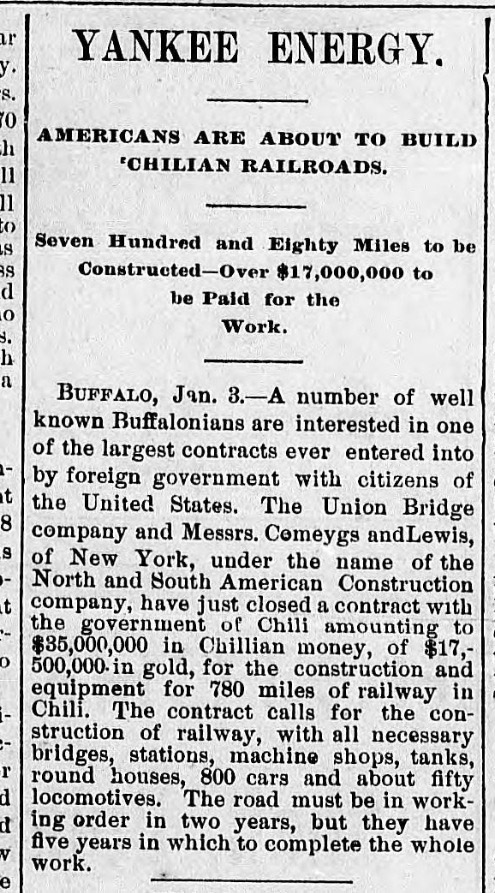
“The contract calls for the construction of railway, with all necessary bridges, stations, machine shops, tanks, round-houses, 800 cars and about fifty locomotives. The road must be in working order in two years, but they have five years in which to complete the whole work.” [The Great Falls Tribune Jan 5th 1889]. The last sentence was not in fact correct; the contract actually specified that the Santiago to Melipilla, Pelequen to Peumo, Palmilla to Alcones, and Huasco to Vallenar lines should be completed within two years; the Calera to La Ligua and Cabildo, Los Vilos to Illapel and Salamanca, Constitucion to Talca, and Coihue to Mulchen routes within three years; and the three parts of the Victoria to Valdivia and Osorno mainline within five years.
More detail published in Railroad Engineering in January 1889.
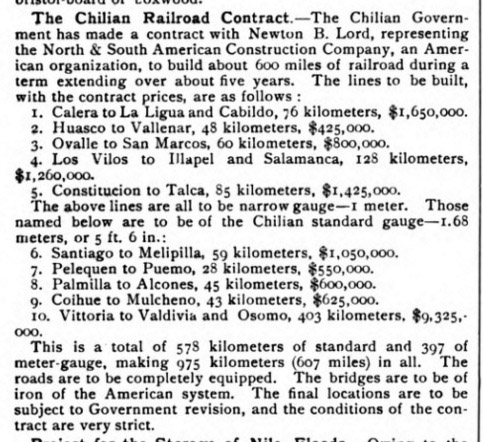
Whilst materials including the locomotives listed below were ordered and despatched to Chile, and engineers and workers were taken on, it became apparent in mid 1889 that the Chilean end of the operation, that had been run by Lewis and Lord, was in a bad way. Lewis and Lord had fallen out, a considerable amount of money was owed to creditors and the government seems to have ‘soured’ on the whole scheme. General Field, visiting Chile in June 1889, felt that he had no option but to arrange the sale of the assets and liabilities of the company in Chile, eventually to Señor Julio Bernstein. Amongst other things Señor Bernstein had been the entrepreneur of the sugar refinery in Viña del Mar.
The Railroad Gazette in December 1889 was decidedly downcast.
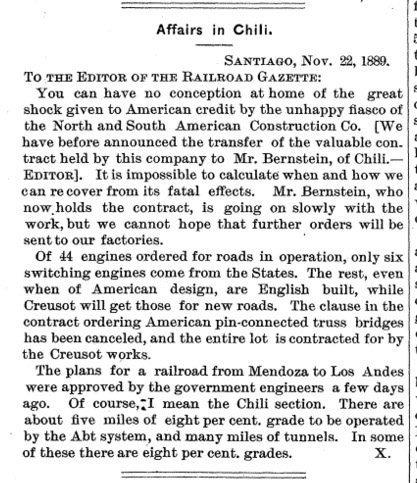
At this point various law-suits began, by Messrs. Comegys, Lewis and Wyman against “Field and associates’ alleging fraud, and by the company against the Chilean government of José Manuel Balmaceda. The first of these was thrown out by a New York court, and the other seems to have come up against the refusal of the Chilean government to accept international arbitration (an attitude that they were entitled to take, the contract having specified that the contracting organisation would be treated as if it were based in Chile rather than overseas). On October 7th 1889, at a meeting in Louisville, Kentucky, the directors were authorised to continue or to wind up the company as seemed appropriate [MOBR287].
In the meantime Balmaceda's government, which was acting increasingly autocratically, had ordered Señor Bernstein to bring the workforce up to almost 15,000 labourers. Bernstein had refused, and the government thereupon expropriated all the assets of the project, on the grounds that completing the tasks within the prescribed time-scale was now impossible. These assets included the following items which had been acquired:
46,000 tonnes of rails.
5,000m of metal bridges.
275 wagons for the operational railways.
14 locomotives.
drilling machines for tunnels.
locomotives and wagons for use during construction works.
2,000,000 feet of Oregon pine.
400,000 sleepers.
20,000 barrels of cement.
20,000 quintals of galvanised iron.
The N&SACCo. had ordered fourteen Baldwin 4-4-0s for use on the building works and then for regular mainline use. Here is one of them, no. 262 ‘PEÑAFLOR’. These engines eventually joined similar but older machines in the EFE fleet and became tipo 15.
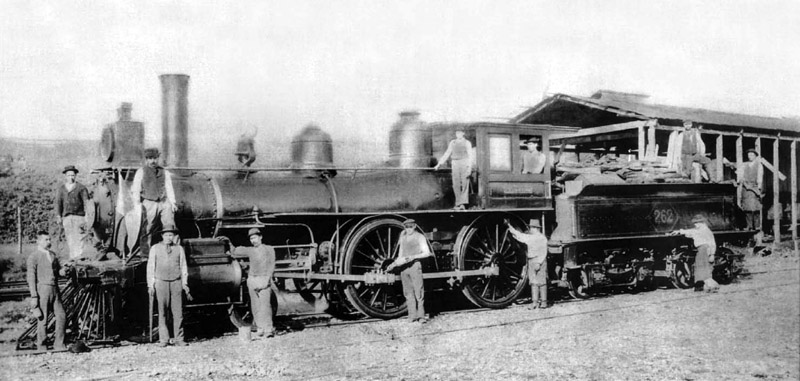
Señor Bernstein then died in January 1891, adding to the legal complications within Chile. These included difficulties caused by the incorrect original registration of the company in Kentucky and by the transfer of rights to Bernstein without approval from the government as had been required, and arguments as to whether or not Bernstein's descendants inherited those rights
Of course, only a few months after all this, civil war broke out in Chile between Balmaceda's supporters and the Chilean Congress, with the result that Balmaceda was defeated, he himself committing suicide in the Argentine legation during September 1891.
The afore-mentioned list of assets includes the fourteen broad gauge 4-4-0 locos which been ordered from Baldwin in March 1889 (as clearly detailed in the broad gauge locos list available here). There is no mention of metre gauge locos for the operating railways, but the construction locos and stock mentioned in item six of the list seems to have included three metre gauge engines [DOP memoria 1891, p19]. A list of suppliers to the company includes solely Browne Beéche & Co. in relation to rolling stock. That trading house based in Valparaiso and New York worked with Baldwin, and was one of the names in the succession from Hemenway & Browne through to Wessel Duval, who are still active.
The agreed complement of workers for each broad gauge line in May 1889 is also given as this will give some idea of the relative importance of each section and thus of the possible division of the fourteen locos had the works continued.
Santiago to Melipilla 59km. 700 workers
Pelequen to Peumo 25km. 200 workers
Palmilla to Alcones 45km. 250 workers
Coihue to Mulchen 45km. 375 workers
Victoria to Valdivia and Osorno 403km. 325 workers engaged on first section
Sources
New York Herald Feb 17 1891, Salem Daily News Feb 2 1889, and other US newspapers. DOP and EFE ‘boletines’ and ‘memorias’ of the time, mostly found in the Hathi Trust archive online. Also Documentos jenerales sobre la “North and South American Construction Company”, para el uso del Tribunal Arbitral de Ferrocarriles, Santiago de Chile: Impr. Barcelona, 1897; and Exposición presentada al gobierno / por la Compañía Constructora de Ferrocarriles, by Juan A. Palazuelos, Compañía Constructora de Ferrocarriles, published 1892.
There is much extra material in MOBR287 and MOBR354 but not all of it has yet been examined.]
Contracts announced in The Railroad & Engineering Journal, vol. 63, Jan. 1889, p50, complements of workers found in [MOBR354].
The Literary Digest of January 30th 1892 was blisteringly dismissive of the whole scheme.
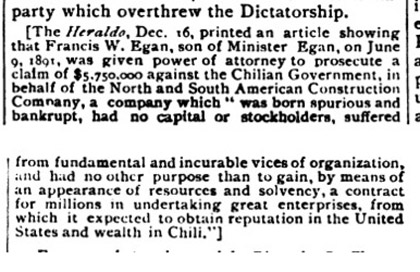
7-3-2018